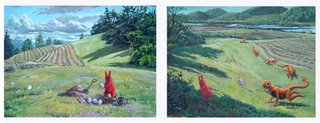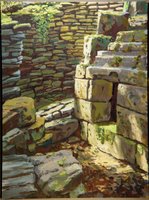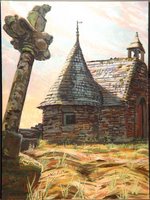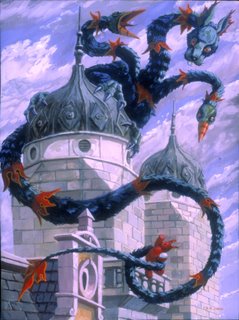P. A. HLuchan Artwork
Monday, August 14, 2006
Monday, August 07, 2006
Thursday, August 03, 2006
A series from my sketchbook
Here are a few ink wash drawings from a series that has been going in my sketchbook for some time. It follows the misfortunes of a young man with romantic ideas. It starts with his rural childhood, his loss of fortune in the city, his embarrassing attempt at becoming an actor, his eventual imprisonment and conscription into the army.










Wednesday, August 02, 2006
Tuesday, August 01, 2006
Here is an artice about my work. http://www.spareroom.org/invisible/in_words.html
| in/words |
An Interview with Pahl Hluchan by Joe Stauber After studying animation and painting at Rhode Island School of Design and Yale, Pahl Hluchan developed a series of haunting images in the guise of children's tales. The narratives twist from the confusion of innocents to the wonder of the sinister, turning the nursery school illustrations into food for a hungry windigo. I spoke with him following his recent exhibition at Bellwether Gallery. Do you make distinctions between roles of so-called “high art” and animation? RISD had a "fine art" slant in their animation, so it wasn't Disney animation but more geared for being independent animator, working on our own creative vision. It wasn't very product oriented. So I think there is a great influence on my work, first in terms of narrative. As a narrative painter all of my work is about storytelling, and there's a long tradition of surrealism or symbolism in animation. It's not unusual for a tree to start talking to someone, and the very premise of a talking mouse is a surreal idea. So there's a definite connection there. I also learned a lot about composition and lighting from working as an animator and filmmaker, like how to create dramatic mood through the light. I think it's been a major influence in terms of subject matter, on how I conceive and compose space. How does an image relates to the corners of the screen? What's on camera what's off camera? What's the motivation for the lighting? So do you link yourself the surrealists? No, I don't really fit into their manifesto. I'm more of a symbolist, I think, because I'm not using random imagery. There is a continuous tradition of surrealism in Czechoslovakia unbroken since the nineteen thirties. An animator that is still one of my greatest influences today is Jan Svankmajer, the animator from the Czech surrealist society. Your Red Rabbit paintings at Bellwether reminded me of illustrations for a children's book. The wonderful places and creatures became part of an illusionary innocence. Somehow this was luring me in under one guise and slowly it seeped in that something else was going on. That is one thing I like to play with, the illustrative quality. A children's story book and my paintings are often both about innocence. A character who is innocent or doesn't know a lot, or who is inexperienced with the world, reacts to that world out of confusion or fear. They inhabit this illustrative format that emphasizes these emotions of the innocent, though innocent things might not be happening. Somewhat sexual but reproductive images are being used, so there is an innocent character being confronted with a complex and confusing world. In the Red Rabbit paintings there is a very strong sense of narrative, but it was never quite nailed down. It isn't always clear how things fit. One needs to look at quite a few to start generating any specific story past the reproductive struggle. There always seemed to be some thing else going on just out of reach in the ambiguity. I don't like to hit people over the head with the imagery, or make something too obvious. When I know exactly what I mean, or the image is too obvious to me, then I think the image becomes preachy. Then I'm up on a high horse and saying something obvious. I might believe in what I say, but it's like saying “racism is bad.” An article in the New York Times about the Ku Klux Klan would educate people better about racism than what I can do in my paintings. So often I like images that are open to many different interpretations. When I'm making an image I'll stop when it is still open to different kinds of stories, even conflicting or dual interpretations. I see Ida Applebroog's work and feel that I know what's going on and at the same time I know that my ideas don't all add up. I find her paintings to deposit some sort of residue on me that I end up walking around in. This happened to me with the Red Rabbit paintings, too. I found them stuck to me after I had left the gallery. When an image that gets under my skin and feels right, I will often figure out a year later what it's doing. But that's when I know I'm hitting on something interesting. Your characters, the red rabbit, the spermy guys, and what I called the god rabbit, where do they come from? Often what I do is try to create some sort of mystery and then make variations on what I started before. So, red rabbit to blue rabbit, and then what if I make him transparent and airy. OK, so that makes him seem ethereal. So then I realized that in Kandinsky's color symbolism, red is earth and blue represents the spiritual. It's somewhat accidental at first, and then I start developing it as the accidental pieces inspire me. Put the egg inside the blue rabbit because he doesn't have to fret in the real world. Red rabbit in the paintings is trying to get eggs or protect eggs. The red rabbit is complete and self-satisfied with blue rabbit. The ideas don't start off logically, or symbolically. They're more random or silly. That's the starting point to break the blank page. I can see the narrative evolving through its twists and turns in all the rabbit paintings, how they developed from the first one with the rabbit just standing in a corner of a room. It starts out seemingly to be a dumb idea, from this vague memory I have from being a kid. I put red teddy bear rabbit in the corner of the room and that was the beginning. He looks like a green rabbit I had as a kid. I painted it red because I had red paint. I wanted him to stand out from the background… red was bright, so…red rabbit. So what goes with rabbits… and I thought eggs go with rabbits with the Easter thing. And then what goes with eggs, well sperm goes with eggs. So the narrative… Just evolved. Yeah, it evolved from a very impulsive idea that happened to get painted. Maybe from a childhood obsession. So now you have had these fellows around now for a while, and they seem to be about nature and culture. There's an innocent character, in a world with little control over what goes on around him. He is thrust in to this world and into a role because he is apart from nature. He is expected to fit into this cycle yet he is not sure if he wants to or not. It's not necessarily good for him as an individual, but is part of this evolution, of keeping the cycle of life going. So red rabbit plays the individual. The individual within culture. I like to play with the question of culture or nature. He is born in to it. He is a part of it, and he has strong desires that come from nature. The desire for eggs, which can be equated with sex, or the desire to eat. The Stuff we are born with that serve the propagation of species. How do you see yourself as an artist, outside the realm of the art narrative? How does your compulsion to produce fit into nature? It's about figuring out how I feel about the world. I don't always know where I stand on a particular issue. It's to communicate how I feel, which is often times confused. |





























